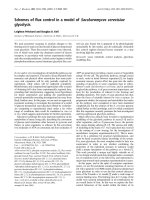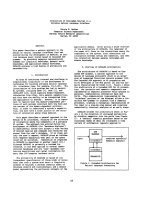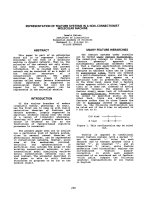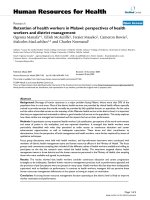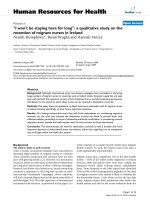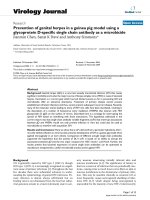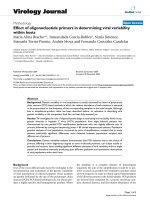Báo cáo sinh học: "Impact of the use of cryobank samples in a selected cattle breed: a simulation study" potx
Bạn đang xem bản rút gọn của tài liệu. Xem và tải ngay bản đầy đủ của tài liệu tại đây (320.83 KB, 28 trang )
This Provisional PDF corresponds to the article as it appeared upon acceptance. Fully formatted
PDF and full text (HTML) versions will be made available soon.
Impact of the use of cryobank samples in a selected cattle breed: a simulation
study
Genetics Selection Evolution 2011, 43:36 doi:10.1186/1297-9686-43-36
Gregoire Leroy ()
Coralie Danchin-Burge ()
Etienne Verrier ()
ISSN 1297-9686
Article type Research
Submission date 5 May 2011
Acceptance date 2 November 2011
Publication date 2 November 2011
Article URL />This peer-reviewed article was published immediately upon acceptance. It can be downloaded,
printed and distributed freely for any purposes (see copyright notice below).
Articles in Genetics Selection Evolution are listed in PubMed and archived at PubMed Central.
For information about publishing your research in Genetics Selection Evolution or any BioMed
Central journal, go to
/>For information about other BioMed Central publications go to
/>Genetics Selection Evolution
© 2011 Leroy et al. ; licensee BioMed Central Ltd.
This is an open access article distributed under the terms of the Creative Commons Attribution License ( />which permits unrestricted use, distribution, and reproduction in any medium, provided the original work is properly cited.
- 1 -
Impact of the use of cryobank samples in a selected
cattle breed: a simulation study
Grégoire Leroy
1,2
*, Coralie Danchin-Burge
2,3
, Etienne Verrier
1,2
1
AgroParisTech, UMR 1313 Génétique Animale et Biologie Intégrative, 16 rue
Claude Bernard, 75231 Paris 05, France
2
INRA, UMR 1313 Génétique Animale et Biologie Intégrative, 78350 Jouy-en-Josas,
France
3
Institut de l’Elevage, 149 rue de Bercy, 75012 Paris, France
*Corresponding author
Email addresses:
GL:
CDB:
EV:
- 2 -
Abstract
Background:
High selection pressure on domestic cattle has led to an undesirable increase in
inbreeding, as well as to the deterioration of some functional traits which are
indirectly selected. Semen stored in a cryobank may be a useful way to redirect
selection or limit the loss of genetic diversity in a selected breed. The purpose of this
study was to analyse the efficiency of current cryobank sampling methods, by
investigating the benefits of using cryopreserved semen in a selection scheme several
generations after the semen was collected.
Methods:
The theoretical impact of using cryopreserved semen in a selection scheme of a dairy
cattle breed was investigated by simulating various scenarios involving two
negatively correlated traits and a change in genetic variability of the breed.
Results:
Our results indicate that using cryopreserved semen to redirect selection will have an
impact on negatively selected traits only if it is combined with major changes in
selection objectives or practices. If the purpose is to increase genetic diversity in the
breed, it can be a viable option.
Conclusions:
Using cryopreserved semen to redirect selection or to improve genetic diversity
should be carried out with caution, by considering the pros and cons of prospective
changes in genetic diversity and the value of the selected traits. However, the use of
genomic information should lead to more interesting perspectives to choose which
animals to store in a cryobank and to increase the value of cryobank collections for
selected breeds.
- 3 -
Background
Within the context of farm animal biotechnologies, cryopreservation is one of the
most useful tools for selection improvement, dissemination of genetic progress and ex
situ conservation. In its Global Plan of Action, the FAO [1] recommended the
implementation of ex situ programmes to complement in situ conservation of animal
genetic resources. It was also suggested that cryopreserved bio-specimens could be
used as a backup material to redirect the selection scheme of a given breed, if needed
[2,3]. Consequently, several gene banks have been created with different strategies
and policies that vary with the breed, species, and country concerned [4,5] and
methods have been proposed to use ex situ genetic resources to optimise the
management of genetic diversity in endangered breeds [6]. Breeds with large
populations are subject to high selection pressures and have rates of inbreeding
greater than the desired values [7]. In these cases, the use of stored semen from male
ancestors has seldom been investigated, although breeding organisations could be
interested in doing so. For instance, in the dairy cattle breed Abondance (a local
selected breed in the French Northern Alps), the semen of a bull born in 1977 (called
Naif), which was rarely used in the 1980’s, was used from 2004 to 2007, to produce
20 young bulls in order to reintroduce some genetic variability in the breed.
Depending on the country, different strategies have been implemented to sample
individuals for national collections. In the Netherlands, most of the tested bulls are
sampled for preservation in the gene bank [8], while in the USA, the selection of
animals for cryopreservation is aimed at optimizing genetic diversity within the
collection, by sampling animals from clusters determined through computed
genealogical relationships [9]. In France, based on the idea that individuals sampled
- 4 -
for a cryobank should be as diverse as possible and carry special genotypes [10],
regulations have been implemented to conserve frozen sperm from three main origins:
(I) animals from endangered breeds, (II) original animals from non-endangered breeds
(with either extreme positive or negative Estimated Breeding Values (EBV), carrying
rare alleles or representing rare pedigree lines), and (III) representative animals from
non-endangered breeds [2].
The purpose of this study was to analyse the efficiency of current cryobank sampling
methods by investigating the benefits of using cryopreserved semen in a selection
scheme several generations after the semen was collected. Based on simulations, we
examined two situations in which cryopreserved sperm was used (1) to redirect the
selection goal, by including a trait which, in the past, had shown a negative correlated
selection response (e.g. fertility in dairy cattle), and (2) to limit the loss of genetic
diversity in the breed. The impact of using cryopreserved sperm was measured by
estimating the evolution of two negatively correlated traits and the evolution of the
breed’s genetic diversity, assessed through pedigree information.
Methods
Simulated breed
A simplified cattle breed was simulated with 13 discrete generations, each consisting
of 100 males and 10000 females. In each generation, 10 bulls and 50 cows were
chosen as parents of the male progeny, and 20 bulls and 10000 cows were chosen as
parents of the female progeny (with no selection on the dam to dam path). Mating was
random resulting in random variation of progeny size among parents, i.e. the sire and
dam of a given newborn were randomly chosen in the corresponding lists of parents.
- 5 -
Simulation of genetic values and EBV
We considered two traits A and B. Trait A corresponded to a production trait which
had been recently and intensively selected and improved (such as milk production in
dairy cattle). Trait B corresponded to a functional trait which had deteriorated because
of a negative correlation with trait A (e.g. fertility or longevity). The genetic standard
deviation of each trait (σ
A
and σ
B
, respectively) was set to 1 and the correlation
between traits (ρ) was set to -0.3.
For each trait, an additive polygenic model was assumed and the simulation of
correlated genetic values was based on the bivariate normal distribution (see, e.g.
[11]). At generation 0 (base population), genetic values for trait A were randomly and
independently drawn from a N (0,1) distribution. For a given individual (i), the
genetic value for trait B (B
i
) was generated from its value for trait A (A
i
):
B
i
= ρ A
i
+ √(1- ρ²) β
i
(1)
where β
i
is a N (0,1) random number independent of A
i
.
In the following generations, genetic values of individual i were simulated from the
genetic values of its sire (A
p
and B
p
) and its dam (A
m
and B
m
), taking into account the
parent’s coefficients of inbreeding (F
p
and F
m
, resp.) [12,13]:
A
i
= ½ (A
p
+ A
m
) + γ
i
√ ½ [1 – (F
p
+ F
m
) / 2] (2.a)
B
i
= ½ (B
p
+ B
m
) + δ
i
√ ½ [1 – (F
p
+ F
m
) / 2] (2.b)
In these equations, γ
i
and δ
i
are two numbers randomly drawn from a N (0,1) bivariate
normal distribution with a correlation equal to ρ.
- 6 -
EBV were directly simulated from genetic values, assuming an evaluation procedure
leading to an accuracy (CD = square of the correlation between the EBV and the true
genetic value) equal to 0.6 for bulls and 0.4 for cows, whatever the trait and the
generation considered. Therefore, the EBV of a given individual for trait A (EBVA
i
)
and for trait B (EBVB
i
) were computed as follows:
EBVA
i
= CD
i
A
i
+ ε
i
√ CD
i
(1- CD
i
) (3.a)
EBVB
i
= CD
i
B
i
+ φ
i
√ CD
i
(1- CD
i
) (3.b)
where ε
i
and φ
i
are two independent numbers drawn from a N(0,1) distribution.
Finally, a Total Merit Index (TMI
i
) was computed, weighting the two EBV by w
A
and
w
B
= 1 - w
A
, respectively:
TMI
i
= w
A
EBVA
i
+ w
B
EBVB
i
(3.c)
Sampling and use of cryopreserved semen
Simulations comprised two stages. During stage 1 (generations 0 to 8), the lists of
parents were selected based on their EBV for trait A only, without considering the
evolution of the genetic mean for trait B or the average coefficient of inbreeding.
During stage 2 (generations 9 to 12), the bulls were also used to improve trait B or to
introduce genetic diversity in the breed.
During stage 1, the semen of some bulls was sampled and cryopreserved if the
animals fulfilled one of the three following conditions, which correspond to the
current sampling rules of the French National Cryobank for type “II” (original bulls)
[2]:
- (i) EBVA is three standard deviations above or below the mean of the
generation,
- 7 -
- (ii) EBVB is two standard deviations above the mean of the generation (trait B
is considered as a functional trait and for functional traits, only animals above
the average are considered),
- (iii) the bull is a sire of sires with no male offspring selected after the
evaluation process (these bulls were actually selected with one generation lag).
To check the validity of this elaborate sampling method, we tested a simpler sampling
method (similar to the one used in the Netherlands), where the semen of all young
bulls is stored in the cryobank.
In the simulations performed here, we investigated the impact of a one-time use (i.e.
during a single generation) of cryopreserved semen.
At generation 9, four bulls with cryopreserved semen were selected (hereafter referred
to as ‘cryobank bulls’), these bulls fulfilling one of the following conditions either (i)
they are the best cryobank bulls for the TMI
i
or (ii) they have the lowest average
kinship with the existing population (males and females taken together). We studied
the impact of various selection orientations (use of cryopreserved semen, conservation
of male lines, etc.) only on the male path, because applying the above conditions on
the female path would be much more restrictive, less effective, and would require a
larger amount of semen, all the more since the number of doses is generally limited in
cryobanks (200, in France) [2].
For these reasons, we considered that cryobank bulls were used only to procreate
young bulls for progeny testing. The 9
th
generation of young bulls was then generated
using either the bulls from the cryobank or the group of 10 sires selected as described
in previous sections. Depending on the scenario (see following section), 0, 40 or 80
- 8 -
individuals (among the 100 newborn bull calves) were sired randomly by one of the
four selected cryobank bulls.
Simulation scenarios and results
Six simulation scenarios were completed with two main options (Table 1).
Firstly, in scenario “b”, emphasis was put on the selection of both traits B and A. To
achieve this goal, three methods were compared:
- b1: at generation 9, the four bulls with the highest TMI (w
B
= 0.5) were used to
sire 40% of the young bulls, while the selection criterion during stage 2
remained unchanged (improving EBVA). The other young bulls were sired by
bulls randomly sampled within the group of 10 sires;
- b2: at generation 9, no cryobank bull was used, and during stage 2, TMI (w
B
=
0.5) was used as the selection criterion instead of EBVA;
- b3: at generation 9, the four cryobank bulls with the highest TMI were used to
sire 40% of the young bulls, and during stage 2, TMI was used as the selection
criterion instead of EBVA. To test more or less drastic selection changes,
scenario b3 was tested with an increasing weight given to trait B (w
B
increasing from 0.5 to 1).
Secondly, in scenarios “d”, emphasis was put on genetic variability while trait A
remained the breeding goal. Three methods were also compared:
- d1: at generation 9, the four cryobank bulls having the lowest kinship with the
existing population (scenario b1) were used to sire 40% of the young bulls;
- d2: at generation 9, no cryobank bull was used, while during stage 2, the
progenies on the sire to sire path were given the same size i.e. for each sire of
- 9 -
sires, 10 male offspring were created among which those with the two best
EBVA became the sires of dams and that with the best EBVA became a sire of
sires;
- d3: at generation 9, the four cryobank bulls having the lowest kinship with the
existing population (scenario b1) were used to sire 40% of the young bulls,
while during stage 2, selection was used to equalise progeny sizes on the sire
to sire path.
Simulations were performed with 1000 runs for each scenario. For each generation,
individual inbreeding coefficients and genetic values were computed and averaged for
the entire male and female populations. The individual coefficients of kinship were
also computed and averaged over males only and over the entire populations. The
proportion of genes originating from cryobank bulls was computed on the basis of the
gene dropping procedure (one locus averaged over the 1000 runs).
Results
Stage 1: evolution of selected traits, diversity loss, and sampling of cryobank
bulls
As expected, the results of the different scenarios did not differ significantly for
generations 0 to 8 given that in stage 1, the conditions were the same whatever the
option chosen, (here we present results averaged over the 1000 runs of one scenario
only). With the parameters chosen for the simulation, each sire of sires had on average
10 male offspring (across sires standard deviation s.d. = 2.9) and each sire of dams
had on average 500 female offspring (across sires s.d. = 21.6). As expected (see
Figure 1), selection on trait A during stage 1 led to a major increase in the mean of
this trait (+ 6.7 initial genetic standard deviation) from generation 0 to 8, while at the
- 10 -
same time, the mean of B decreased to a lesser extent (-2 initial genetic standard
deviation). The average coefficient of inbreeding increased simultaneously. Young
bulls were slightly more inbred than cows, as they originated from a smaller number
of sires and dams. In parallel (generation 0 to 8), the average coefficient of kinship
among the young bulls and among the entire population increased to 8.1% and 6.9%,
respectively.
An average of 31 cryobank bulls was sampled per replicate, 58% being sampled
because of outstanding EBVB (see Table 2). Table 2 shows that cryobank bulls chosen
for their genetic diversity were generally born earlier than others, which can be
explained by the fact that they were chosen with one generation lag compared to other
sampling procedures.
Stage 2 in scenarios b: change in breeding goals
As shown in Figure 1, introducing cryobank bulls with exceptional TMI without
changing the selection criterion during stage 2 (scenario b1) had a temporary impact
on traits A and B as well as on the diversity indicators of the young bulls. At the
whole population level, the impact was negligible, since young bulls sired by
cryobank bulls were rarely subsequently selected as sires: three generations after
introduction (generation 12), the cryobank contribution to genetic diversity was less
than 3% (Table 3).
When TMI was used as a selection criterion (considering w
B
= 0.5), without using
cryobank bulls (scenario b2), there was a per generation increase in the mean of trait
B from generation 9 on (b1 : -0.3 vs b2 : +0.4), while the genetic gain for trait A
decreased (b1 : +1.0 vs b2 : +0.4, see additional file 1). The change in breeding goals
had no impact on diversity indicators.
- 11 -
Combining the use of cryobank bulls and TMI as a selection criterion (scenario b3 for
w
B
= 0.5) resulted in a slight but significant (P<0.001) reduction in average kinship (-
0.3% between scenario b2 and b3, with 40% of the males from generation 9 sired by
cryobank bulls, see additional file 2). Concerning the selected traits, the genetic gain
for trait A decreased slightly when cryobank bulls were used (-0.12 between scenarios
b2 and b3, P<0.001), while the genetic gain for trait B increased slightly (+0.06
between scenarios b2 and b3, P = 0.02). These tendencies increased slightly when
80% of the males from generation 9 were sired by cryobank bulls (see additional file
2). According to the results from Table 3, cryobank bulls contributed to 6.5% of the
diversity three generations after their introduction. It should be noted that the
cryobank bulls used were generally sampled in recent generations, their average birth
generation being 6.6 (Table 3).
As a result of the increased weight of trait B within TMI (see Figure 2), there was a
per generation increase in genetic gain for trait B, while there was a slightly lower
increase or even a decrease in genetic gain for trait A, as well as in average kinship,
when trait B accounted for more than 80% of EBV. When only trait B was taken into
account for TMI, the genetic value of traits A and B reached 4.7 and 1.37, respectively
at generation 12 (versus 8.4 and -0.41 respectively when w
B
= 0.5), while average
kinship reached 8.9% at generation 12 (versus 11.9% when w
B
= 0.5).
Stage 2 in scenarios d: improvement in genetic diversity
As shown in Figure 3, the use of cryobank bulls with a minimised kinship with the
current generation (scenario d1), had no impact if the selection policy was not
modified, since none of the offspring of the cryobank bulls were selected as sires.
Equalising progeny sizes on the sire to sire path alone (scenario d2) decreased
- 12 -
diversity a little less (in generation 12, Φ = 12% for scenario d1 and Φ = 11% for
scenario d2), with an almost negligible impact on genetic progress. Combining this
option with the introgression of cryobank bulls (scenario d3) resulted in a significant
reduction in average kinship (-2% in comparison to d1). Under such a scenario, the
genetic mean of trait B also increased slightly (+0.3 between scenario d1 and d3,
P<0.001), while that of trait A and the average of both traits decreased slightly (-0.08
and -0.02 respectively, between scenarios d1 and d3, P<0.001). It should be noted that
most of the cryobank bulls used originated from the founder population, their average
birth generation being 0.3 (Table 3).
Modifying which bulls entered the cryobank by preserving semen for all the young
bulls did not significantly alter the results of scenarios b3 and d3, either for the
selected traits or for kinship evolution (data not shown). It should be noted that in this
case, the average birth generation of the cryobank bulls used was 7, in scenario b3
(instead of 6.6, in the first cryobank sampling method), and 0, in scenario d3 (instead
of 0.3, in the first cryobank sampling method).
Discussion
In this study, we assessed the impacts of using cryopreserved bull semen either to
redirect selection or to improve the genetic variability of a selected cattle breed.
Simulation parameters were chosen as a compromise between realism in the
scenarios, their applicability, and the simplicity of the model. For instance, with
respect to the choice of population size, a breed with 20 breeding males and 10000
potential dams could be considered quite small, especially with reference to the FAO
endangerment status [14]. In our simulation, sires and dams were randomly chosen
- 13 -
from lists of reproducers. This differs significantly from what occurs in real breeds, in
which an unbalanced use of reproducers is frequently the case, leading to a reduced
size of the effective population. In terms of effective size, our breed would correspond
to a much larger population with a similar inbreeding rate per generation (1.07%) to
that found in real dairy cattle breeds e.g. [15]
.
Concerning sampling conditions in the simulations, as mentioned above, the
procedure chosen to select bulls for cryopreservation is similar to that currently
applied in France. This choice was made to test if bulls selected this way could be
effectively used in a selected breed. Compared to the case in which all young bulls are
sampled for cryopreservation (which corresponds more or less to the current
procedure in the Netherlands), the results were basically the same. This shows that the
French sampling procedure is reasonably efficient to select useful bulls, and could be
applied in situations when only a limited number of semen samples can be stored in a
cryobank (for financial reasons, for instance).
One of the main conclusions of this study is that using cryopreserved semen is
relevant for a breed for which major changes in selection objectives or practices are
considered. Since genetic progress is rapid in dairy cattle breeds (e.g. [16]), a bull for
which semen has been stored for a few generations, is likely to have a lower genetic
value than current bulls, if the selection goals remain the same. Thus the latter’s
offspring may not be used, as illustrated by scenarios b1 and d1, and using cryobank
bulls is then meaningless. The results of scenario b3 demonstrate that using cryobank
bulls has a significant impact on the selected traits and on genetic diversity only if a
relatively large change is implemented in the selection programme (i.e. introducing a
- 14 -
new trait formerly negatively selected but subsequently accounting for more than 50%
of EBV). Under that scenario, when trait B accounted for less than 70% of EBV, the
cryobank bulls selected were those more recently collected, since they generally had a
higher value for trait A than older cryobank bulls, which compensated for a slightly
lower value for trait B. When trait B accounted for 80% or more of EBV, most of the
cryobank bulls finally used, originated from generation 0 (data not shown), which
explains the sudden decrease in average kinship after introgression of the cryobank
bulls (see Figure 2). Therefore if managers of a selection scheme want to redirect
breeding goals, using cryobank bulls is viable only if the breeding goals are subjected
to a major modification (i.e. if the weight of the new trait accounts for more than 50%
of EBV). Our results also indicate that cryobank bulls that have been sampled for
functional traits with high EBV will tend to be used more frequently than other
cryobank bulls, independently of the aim.
If the objective is to introduce genetic diversity into the breed, using cryobank bulls
appears to be a valid choice. However, it is imperative that other measures are also
taken to guaranty that genes are spread within the breed i.e. either conserving male
lines (scenario d3), when their use is promoted among breeders, or setting up more
restrictive and effective breeding schemes. Several methods of varying complexity
have been proposed to minimise kinship [6], or to maximise breeding values for a
predefined inbreeding rate [17], or to minimise average kinship for a desired average
EBV [18], usually by optimising the contribution of reproducers.
On the one hand, decreasing inbreeding in a selected breed may improve selected
traits; for instance, it has been shown that in Holstein cattle, milk production (over
305 days) can decrease by about 20 litres per 1% inbreeding increase [19]. On the
- 15 -
other hand, using semen from cryobank bulls has a negative impact on previously
selected traits, as illustrated by our simulations. In the case of local breeds, in which
genetic progress is not as effective as in breeds with a larger population size, the
difference in EBV between current bulls and bulls from earlier generations should be
minimised. This could lead to an effective use of cryobank bulls to reintroduce
diversity without overly affecting selected traits. As an illustration in the Abondance
breed, one of the male offspring of the bull born in 1977 was found to have quite a
high EBV (Vaccin, born in 2003, [20]), and was therefore recently confirmed as a sire
of dams. Among all the sires of dams, this bull shared the lowest average kinship with
the 2004-2007 female cohorts (4.6% vs. 6.5% on average, personal communication).
The impact of using this bull on the genetic variability of the breed remains to be
assessed.
Conclusions
Based on our results, using semen from cryobank bulls should be useful either to
introduce drastic changes in selection goals or to reintroduce genetic diversity within
a given population. However, it is important to carefully assess the pros and cons of
the potential changes in genetic diversity and values of the selected traits.
Our simulations were based on a classic quantitative selection scheme. Recent
progress in genomic tools should make it possible to identify semen from cryobank
bulls that share specific alleles or QTL of interest for selection. This could then be
taken into account when choosing cryobank bulls as well as how they will be used.
Using such reproducers should be investigated in further studies, which opens
exciting perspectives for an improved exploitation of cryobank collections.
- 16 -
Competing interests
The authors declare that they have no competing interests.
Authors' contributions
EV, CDB and GL jointly conceived the design of the study and discussed the results.
GL wrote and checked the simulation program. GL wrote the first draft of the
manuscript, which was then modified by CDB and EV. All authors read and approved
the final manuscript.
Acknowledgements
This study was funded by the Bureau des Ressources Génétiques (BRG) (Contract
2007-14 “CryoSitu”). The authors wish to thank Emilie Setlakwe, Daphne
Goodfellow and Hélène Hayes for linguistic revision.
References
1. FAO: Global plan of action for animal genetic resources and the
Interlaken declaration; 2007.
2. Verrier E, Danchin-Burge C, Moureaux S, Ollivier L, Tixier-Boichard M,
Boichard D, Maignel MJ, Bidanel JP, Clement F: What should be preserved:
genetic goals and collection protocols for the French National Cryobank.
In Proceedings of the Workshop on Cryopreservation of Animal Genetic
Resources in Europe: 23 February 2003; Paris. Edited by Planchenault D.
Bureau des Ressources Génétiques; 2003:79-89.
3. Gandini G, Oldenbroek K: Strategies for moving from conservation to
utilisation. In Utilisation and conservation of farm animal genetic resources.
- 17 -
Edited by Oldenbroek K. Wageningen: Wageningen Academic Publishers;
2007:29-54.
4. Woelders H, Zuidberg CA, Hiemstra SJ: Animal genetic resources
conservation in The Netherlands and Europe: poultry perspective. Poultry
Sci 2006, 85:216-222.
5. Danchin-Burge C, Hiemstra SJ, Blackburn HD: Ex situ conservation of
Holstein-Friesian cattle - Comparing the Dutch, French and USA
germplasm collections. J Dairy Sci 2011, 94:4100-4108.
6. Sonesson AK, Goddard ME, Meuwissen THE: The use of frozen semen to
minimize inbreeding in small populations. Genet Res 2002, 80:27-30.
7. FAO: FAO Guidelines for the Cryoconservation of Animal Genetic
Resources (Draft); 2010.
8. Danchin-Burge C, Hiemstra SJ: Cryo-preservation of domestic animal
species in France and the Netherlands: Experience, similarities and
differences. In Proceedings of the Workshop on Cryopreservation of Animal
Genetic Resources in Europe: 23 February 2003; Paris. Edited by
Planchenault D. Bureau des Ressources Génétiques; 2003:15-28.
9. Blackburn HD: Genebank development for the conservation of livestock
genetic resources in the United States of America. Livest Sci 2009,
120:196-203.
10. Smith C: Genetic aspects of conservation in farm livestock. Livest Prod Sci
1984, 11:37-48.
11. Verrier E: Marker-assisted selection for the improvement of two
antagonistic traits under mixed inheritance. Genet Sel Evol 2001, 33:17-38.
- 18 -
12. Foulley JL, Chevalet C: Méthode de prise en compte de la consanguinité
dans un modèle simple de simulation des performances. Ann Génét Sél
Anim 1981, 12:189-196.
13. Verrier E, Colleau JJ, Foulley JL: Effect of mass selection on the within-
family genetic variance. Theor Appl Genet 1989, 77: 142-148.
14. Scherf BD (Ed.): World Watch List for Domestic Animal Diversity. 3rd
edition.Edited by FAO. Rome; 2000.
15. Sorensen AC, Sorensen MK, Berg P: Inbreeding in Danish dairy cattle
breeds. J Dairy Sci 2005, 88:1865-1872.
16. Philipsson J, Forabosco F, Jakobsen JH: Monitoring sustainability of
international dairy breeds. Interbull Bull 2009, 40: 288-291.
http://www-
interbull.slu.se/bulletins/bulletin40/Philipsson.pdf
17. Meuwissen TH, Sonesson AK: Maximizing the response of selection with a
predefined rate of inbreeding: overlapping generations. J Anim Sci 1998,
76:2575-2583.
18. Colleau JJ, Tual K, de Preaumont H, Regaldo D: A mating method
accounting for inbreeding and multi-trait selection in dairy cattle
populations. Genet Sel Evol 2009, 41:7.
19. Croquet C, Mayeres P, Gillon A, Vanderick S, Gengler N: Inbreeding
depression for global and partial economic indexes, production, type, and
functional traits. J Dairy Sci 2006, 89:2257-2267.
20. Coopérative d’élevage et d’insémination animale de Haute-Savoie
[
- 19 -
Figures
Figure 1 - Changes in genetic values (a) and in genetic diversity (b) (scenario
b1)
Dotted lines: young bulls; solid lines: whole population; red: trait A, blue: trait B;
green: average between A and B; purple: inbreeding F; pink: kinship Φ
Figure 2 - Changes in genetic values (a) and in average kinship (b), when trait B
was added to selection goals
Scenario b3 and whole population are considered with the weight w
B
of trait B
increasing for computation of the total merit index
Black: w
B
= 0 (scenario b1); brown: w
B
= 0.5; red: w
B
= 0.6; orange: w
B
= 0.7; green:
w
B
= 0.8; light blue: w
B
= 0.9; dark blue: w
B
= 1; o: genetic value for trait A; ♦:
genetic value for trait B; x: kinship Φ
Figure 3 - Changes in genetic values (a) and in average kinship (b), when the
aim was to manage genetic diversity
The whole population is considered
Brown: no change in selection; cryobank bulls used to produce 40% of male offspring
(scenario d1); red: conservation of male lines (scenario d2) (curve overlapping the
preceding one); yellow: conservation of male lines and cryobank bulls used to
produce 40% of male offspring (scenario d3); o: genetic value for trait A; ♦: genetic
value for trait B; dotted line: average genetic value between A and B; x: kinship Φ
- 20 -
Tables
Table 1 - Description of simulation scenarios
Scenarios Use of cryobank bulls in generation 9
Selection scheme
during stage 2
(generations 9-12)
Objective Code
Selection of
cryobank bulls
% of male
offspring
Selection
criterion
Use of sire
of bulls
b1 Higher TMI value 40 EBVA No change
b2 Not used 0 TMI No change
Improving trait B
b3 Higher TMI value 40 TMI No change
d1
Minimizing kinship
with current population
40 EBVA No change
d2 Not used 0 EBVA
Conservation
of male lines
Maintaining
genetic diversity
d3
Minimizing kinship
with current population
40 EBVA
Conservation
of male lines
EBVA: estimated breeding value for trait A; EBVB: estimated breeding value for trait
B; TMI: total merit index computed as the weighted sum of EBVA and EBVB
- 21 -
Table 2 - Average number and birth generation of bulls selected for
conservation
Cryobank sampling criterion
Number of bulls
per replicate
% of all
cryobank bulls
Birth generation
of cryobank bulls
> + 3 s.d. EBVA 0.92 [0.96] 3% 3.52 [1.96]
< - 3 s.d. EBVA 0.95 [0.94] 3% 3.56 [2.03]
> + 2 s.d. EBVB 18 [3.22] 58% 3.5 [0.45]
Sire of sires with no
male offspring
selected
11.2 [2.48] 36% 2.96 [0.48]
Total 30.9 _ 3.3
In brackets, are given the standard deviations (s.d.) between replicates; note that the
sum of the cryobank bulls sampled in each category is larger than the total number of
cryobank bulls because some bulls were chosen for several criteria at the same time
- 22 -
Table 3 - Origin and impact of cryobank bulls used in the different scenarios
Scenario*
b1 b3 d1 d3
> +3 s.d. EBVA 3.3 [8.7] 3 [8.8] 1 [1.8] 1 [1.6]
< -3 s.d. EBVA 3.1 [8.8] 3 [8.2] 4 [1.0] 4 [1.0]
> +2 s.d. EBVB 67.8 [21.2] 67 [21.6] 72 [21.7] 71 [20.6]
Proportion of bulls used
according to the
sampling criterion (%)
Sire of sires with
no male offspring
selected
26.3 [21.2] 27 [21.6] 24 [20.7] 25 [20.2]
Birth generation of cryobank bulls used 6.6 [0.3] 6.6 [0.3] 0.3 [0.3] 0.3 [0.3]
Generation 10 3.6 [2.3] 7.3 [2.8] 0. [0.1] 8.8 [0.9]
Proportion of genes
originating from
cryobank bulls (%)
Generation 12 2.8 [2.9] 6.5 [4.2] 0. [0.0] 6.8 [2.3]
In this case, trait B accounts for 50% of the total merit index
*in scenarios b2 and d2, no cryobank bull was used; in brackets are given the standard
deviations (s.d.) between replicates
- 23 -
Additional files
Additional file 1
File format: PDF
Title: Changes in genetic values (a) and in genetic diversity (b) (scenario b2)
Description: The data represent the simulation results for scenario b2. Dotted lines:
young bulls; solid lines: whole population; red: trait A; blue: trait B; green: average
between A and B; purple: inbreeding F; pink: kinship Φ
Additional file 2
File format: PDF
Title: Changes in genetic values (a) and in average kinship (b) when trait B was
added to selection goals
Description: The data represent the simulation results when selection is redirected
with a new trait accounting for 50% of the total merit index and when the use of
semen from cryobank bulls is increased. .
Scenario b3 and whole population are considered with the weight w
B
given to trait B
accounting for 50% of the total merit index and an increased use of the semen from
cryobank bulls. Brown: no cryobank bull is used (scenario b2); red: cryobank bulls
are used to produce 40% of sons (scenario b3); yellow: cryobank bulls are used to
produce 80% of sons; o: genetic value for trait A; ♦: genetic value for trait B; dotted
line: average genetic value between A and B; x: kinship Φ
Generations Generations
f
b a
Genetic values
Figure 1
